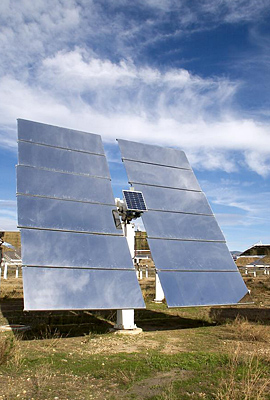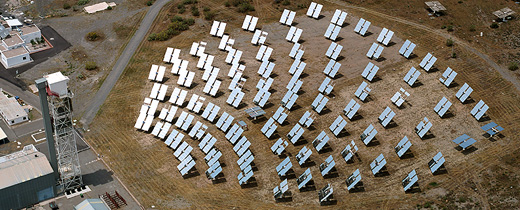

SSPS-CRS
The SSPS-CRS plant was inaugurated as part of the International Energy Agency’s SSPS (Small Solar Power Systems) project in September 1981. Originally conceived to demonstrate continuous electricity generation, it used a receiver cooled by liquid sodium that also acted as the thermal storage medium. At present, this test facility is mainly devoted to testing small solar receivers in the 200 to 500-kWth capacity range.

The heliostat field is composed of 91 39.3-m2 first generation units manufactured by Martin-Marietta. A second field north of it has 20 52-m2 and 65-m2 second-generation heliostats manufactured by MBB and ASINEL.
The original CRS heliostat field was improved several years ago with the conversion of all of its heliostats into completely autonomous units powered by photovoltaic energy, with centralized control communicated by radio using a concept developed and patented by PSA researchers. This first autonomous heliostat field, which does not require the use of channels or cabling, was made possible by financial assistance from the Spanish Ministry of Science and Technology’s PROFIT program.
The nominal average reflectivity value of the field is actually 90%, the solar tracking error is 1.2 mrad per axis and the optical reflected beam quality is 3 mrad. Under typical conditions of 950 W/m2, total field capacity is 2.5 MWth and peak flux is 2.5 MW/m2. 99% of the power is collected in a 2.5-m-diameter circumference and 90% in a 1.8-m circumference.
SPSS-CRS has been used in the past to accommodate testing of small solar receivers in the range of 200-350 kW thermal power applications. More recently, the SSPS-CRS tower has been equipped with a large quantity of auxiliary devices that allow the execution of a wide range of tests in the field of solar thermal chemistry.

The 43-m-high metal tower has three test platforms. The two first are located at 28 and 26 m and prepared for testing new receivers for thermochemical applications. The third test platform is at the top of the tower at 43 m, and houses an enclosed room with crane and calorimetric test bed for the evaluation of solar reactors for hydrogen production. The tower infrastructure is completed with a 4-TN-capacity crane and a 1000-kg-capacity rack elevator. All test levels have access to pressurized air (29dm3/s, 8bar), pure nitrogen supplied by two batteries of 23 standard-bottles (50dm3/225bar) each, steam generators with capacity of 20 and 60kg/h of steam, cooling water with a capacity of up to 700 kW, demineralized water (ASTM type 2) from a 8m3 buffer tank for use in steam generators or directly in the process, and the data network infrastructure consisting of Ethernet cable and optical fiber.
A hybrid heat flux measurement system to measure the incident solar power that is concentrated by the heliostat field is located at the SSPS-CRS tower. This method comprises two measurement systems, one direct and the other indirect. The direct measurement system is located at 43 m level for evaluation of SYNPET reactor. It consists of several heat flux sensors with a 6.32 mm front-face diameter and a response time in microseconds. These micro sensors are placed on a moving bar which is mounted in front of the reactor window. The indirect measurement system is placed at two levels, 32 and 26 in SolH2 and Hydrosol facilities. It works optically with a calibrated CCD camera that uses a water-cooled heat flux sensor as a reference for converting grey-scale levels into heat flux values.